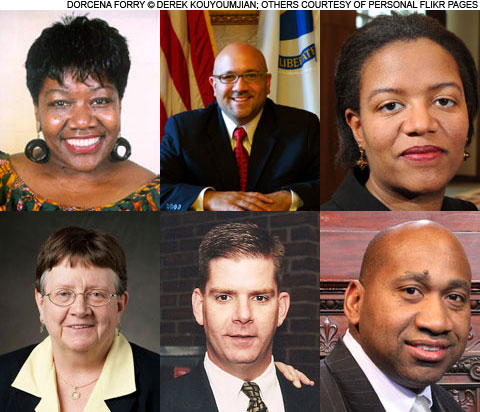
MOVING DAZE Boston’s state legislative map is due for some big changes in 2012, with portions of the districts of (clockwise, from top left) state representatives Gloria Fox, Jeffrey Sanchez, Linda Dorcena Forry, Russell Holmes, Marty Walsh, and Liz Malia changing hands. |
Last week, the state legislature revealed the new redistricting proposal for Massachusetts's state-legislative districts. While minority representation in Boston has been preserved, and even bolstered, changes affecting some of the city's progressive lawmakers may cause some grumbling among their supporters.As best as I can tell, the proposed changes to Boston will become law without a big stink — and that's a testament not only to the members of the Redistricting Committee, but also to the activists from MassVote, Common Cause, the NAACP, the Urban League, Oiste, and other groups that brought unprecedented community involvement to the process. Their big task now will be getting people to actually vote.
That's not to say that everybody is happy — or that more won't get annoyed as they start to learn about the changes, which will take effect for the 2012 elections.
The one neighborhood whose aggrieved cries have reached my ears is Dorchester's Ashmont Hill, most of which is moving from Marty Walsh's House district to Russell Holmes's under the new plan. Another portion of the neighborhood will shift from Holmes to Linda Dorcena Forry.
On the new map, the precincts moving into Holmes's district stand out, almost as an island inside a sea of Walsh's district in the southern part of Dorchester. "You can see how gerrymandered it is," says neighborhood activist Vicki Rugo. "We're being isolated out of a neighborhood where there's been a tremendous amount of cooperation and collaboration."
But it's not just the separation from nearby precincts that is chafing at Ashmont Hill residents. And I don't think this highly diverse and accepting neighborhood is secretly uncomfortable at finding themselves in a black-dominated district.
No, this is a decidedly liberal-leaning crowd, and they are learning that their new representative, Holmes, is considerably more conservative on social issues than Walsh.
The change for that neighborhood, and for several others, was necessitated not only by population shifts, but also by the desire to find appropriate minority mixes, says Michael Moran, the Brighton state representative who co-chaired the Redistricting Committee.
In reality, this means a desire to avoid a legal challenge that would surely come if the new plan didn't represent the rapid growth of the city's black, Hispanic, and Asian populations.
The committee — on which Forry also serves — wanted to preserve the three Boston districts with black majorities. At the same time, it didn't want to raise Holmes's black percentage so high it brings charges of minority "packing," Moran says. Dorchester's Ward 17, which includes Ashmont Hill, became a focal point to balance those numbers.
Most Boston lawmakers are trying to be as diplomatic as possible about the changes. "I'm honored by the residents of [Ashmont Hill] wanting to keep me as their representative," Walsh says. He intends to make sure their objections, and a petition being circulated, get heard by the committee.
Meanwhile, Walsh will need to introduce himself to neighborhoods that will be joining his district, stretching all the way to the Neponset River — and even across it, giving him a small portion of Quincy.